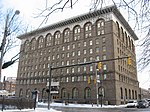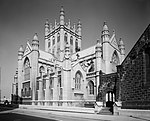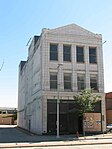The Bert L. and Iris S. Wolstein Center is a 13,610-seat indoor arena located in downtown Cleveland, Ohio, United States, on the campus of Cleveland State University (CSU). It is home to the Cleveland State Vikings men's and women's basketball teams and the Cleveland Charge of the NBA G League. It was also the former home of the Cleveland Crunch and Cleveland Force of the NPSL and MISL. The building opened in 1991 as a replacement for Woodling Gym and was known until 2005 as the CSU Convocation Center. It is named for Bert Wolstein, a Cleveland area real estate developer, former owner of the Force, and CSU alumnus, and his wife Iris. The main arena is known as Henry J. Goodman Arena - named for a businessman and former chairman of the CSU Board of Trustees.
It seats 13,610 for basketball, and with additional floor seating can hold 15,000 for concerts and professional wrestling. In addition to the arena, the Wolstein Center also has a practice gym and grand ballroom. It is the largest basketball arena in the Horizon League and the second-largest college basketball arena in Ohio by seating capacity.
In recent years, Cleveland State has downsized capacity for basketball to 8,500 for most Vikings games. The basketball floor is placed closer to the eastern baseline, and the western third of the arena is curtained off. For many games only lower-level seating is available and upper-level seating sections are covered with tarps, further reducing available seating. The area behind the curtain is used for a variety of other purposes, including a "Kids Fun Zone" children's play area during games, and the curtain itself is adorned with various banners facing the court.The Wolstein Center has also hosted numerous concerts, featuring artists such as David Bowie, Elton John, Martina McBride, TLC, Carrie Underwood, Justin Bieber, Janet Jackson, 311, The Beastie Boys, The Cure, The Blue Man Group and Twenty One Pilots. The arena was site of the 1998 NCAA Division I Wrestling Championships and served as host for first and second-round games of the 2000 and 2005 NCAA Men's Division I Basketball Tournaments as well as the 2019 NCAA Fencing Championships.






